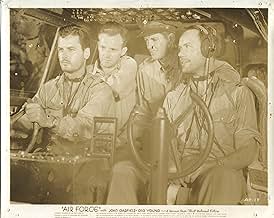The crew of an Air Force bomber arrives in Pearl Harbor in the aftermath of the Japanese attack on December 7, 1941, and is sent on to Manila to help with the defense of the Philippines.The crew of an Air Force bomber arrives in Pearl Harbor in the aftermath of the Japanese attack on December 7, 1941, and is sent on to Manila to help with the defense of the Philippines.The crew of an Air Force bomber arrives in Pearl Harbor in the aftermath of the Japanese attack on December 7, 1941, and is sent on to Manila to help with the defense of the Philippines.
- Won 1 Oscar
- 2 wins & 3 nominations total
Edward Brophy
- Marine Sgt. J.J. Callahan
- (as Edward S. Brophy)
Storyline
Did you know
- TriviaAerial scenes were filmed in Texas and Florida because airplanes appearing to be Japanese were not allowed on the west coast due to a fear of Japanese invasion.
- GoofsDespite reports by Susan McMartin and other characters attributing the loss of planes at Hickham Field and attacks on civilians to Japanese-American saboteurs in bomb-ladened vegetable trucks, there were in fact no actual acts of sabotage. The reports made in the film were propaganda reflecting the hysteria of time.
- Quotes
Sgt. Joe Winocki: [overhearing the Pearl Harbor attack on the radio] Hey, Peterson, who you got tuned in, Orson Welles?
- Crazy creditsOpening credits prologue: FOREWORD "It is for us the living .... to be dedicated here to the unfinished work which they who fought here have thus far so nobly advanced ..... It is ......for us to be here dedicated to the great task remaining before us ..... that this nation, under God, shall have a new birth of freedom and that government of the people, by the people, for the people, shall not perish from the earth." Abraham Lincoln
- ConnectionsEdited into War and Remembrance: Part IV (1988)
- SoundtracksThe Army Air Corps Song
(1939) (uncredited)
("Off We Go Into the Wild Blue Yonder")
Written by Robert Crawford
Played during the opening credits and often throughout the film
Featured review
I gave this an enthusiastic 6, and that's not said sarcastically. If you accept it for what it is, a WWII propaganda film, it is (except for the last half hour) very well done. It was made within the constraints of being a propaganda film, the necessity to maintain dramatic flow, incomplete knowledge at the time of all the facts, and the availability of aircraft that the Army Air Corps could provide. The aircraft are clearly the best thing about the film, though Harry Carey came close to stealing the movie. The aerial battles were staged by Paul Mantz, who was THE best in the business. There were two major weaknesses. The first was the frequent references to 5th column activity. Except for one minor incident in the Kauai area, the Japanese-Americans in Hawaii were singularly loyal to the U.S. The biggest weakness was the totally fictitious battle in the last 30 minutes of the movie. It never happened. The only sea battle in that area during that time frame was the battle of the Java Sea, which was a disaster for the U.S. and Dutch forces. Rather it seemed to be an enhanced composite of the attacks on Japanese convoys in the New Guinea/Solomon Islands area, and the battles of Coral Sea and Midway. We had nothing like the forces portrayed available at that time. The fighters shown at Clark Field were Bell P-39s. They were very pretty little planes, but were such a disappointment they earned the nickname Iron Dogs (all metal and "dogs"). But they still would have been far superior to what was actually available there. Sharp-eyed viewers would see that they were also used to stand in for radial-engined Zeroes (P-39s had liquid-cooled engines), along with radial-engined American trainers in the battle scenes. Also, I am practically certain B-17s didn't have the range to fly from Hickam to Clark with only one refueling stop, but that is justified by the necessity for dramatic flow. One more note - the dramatic picture of the capsizing battleship near the end of the movie was not a model, but rather a film of the Austro-Hungarian Szent Istvan sunk in 1918 during WWI.
- How long is Air Force?Powered by Alexa
Details
- Release date
- Country of origin
- Official site
- Languages
- Also known as
- Archipiélago en llamas
- Filming locations
- Production company
- See more company credits at IMDbPro
Box office
- Budget
- $2,646,000 (estimated)
- Runtime2 hours 4 minutes
- Color
- Aspect ratio
- 1.37 : 1
Contribute to this page
Suggest an edit or add missing content


























